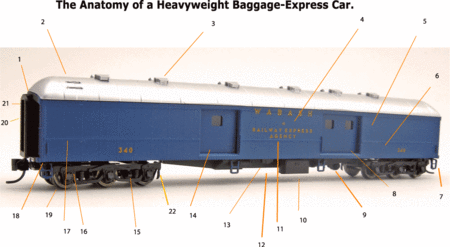Saturday
Mar052011
The Anatomy of A Heavyweight Baggage-Express Car
 Saturday, March 5, 2011 at 12:56PM
Saturday, March 5, 2011 at 12:56PM
- Fowler buffer spring. This is the upper buffer spring. The lower buffer is above the coupler.
- Since the invention of light bulbs and "newer" ventilation systems, the clerestory roof design became obsolete. The arched roof provided a better seal from moisture from inclinent weather than the clerestory.
- Garland roof vents: Designed to provide negative pressure so inside air is exhausted when train is underway. Air exits along the opening parellel to the sides of the car. Air enters on either side, depending on direction of travel.
- A "star" denotes (upgraded) facilities for the baggage/express attendent, including washstand, hopper, desk, and sometimes even a stove.
- Rivet heads - 1/2" to 1" in diameter. Rivets attached the steel side plates to the frame.
- Inside: floors at the ends of cars are typically equipped with "fish racks." These are raised wooden slats that keep goods from getting wet on a moist floor.
- I.C.C. Safety Appliance requirement: Stirrups and grabs.
- Double-wide doors for ease of loading extra wide cargo.
- Dynamo: A belt-driven generator that takes power from the wheel axle.
- 30-volt, 25 cell, 150 AH batteries, typical.
- The Railway Express Agency was a contractor retained to operate package freight business. The REA operated nationwide and seemlessly between connecting railroads. It was the forerunner of today's UPS and FedEx. Canadian National and Canadian Pacific did not contract with the REA but each had their own internally operated LCL-packaged-business unit.
- Built-up fishbelly main girders: originally a Pullman Mfg. Co. idea that was copied by ACF, Standard Steel and others. PRR, SP, UP avoided this design due to the heavy dead weight and the inability for carman to see the other side of underbody equipment. The advantage was that it was cheap to fabricate.
- Westinghouse or New York UC brake valve became standard in 1914. On modern passenger cars, its D-22 and then D-26 brake systems.
- Ply-metal or Met-L-Wood modernized doors replaced the original all wood ones. Essentially they are plywood doors encased in metal. It provide durability and relatively lightness when sliding the door open and close.
- Truck springs: the combination of elliptical and coil springs eliminated harmonic bouncing motion.
- Bolt on pedestals on a Commonwealth frame. It's old school.
- Belt rail provides structural integrity between the lower and upper side plates.
- End sills: specifications were usually taken from either "over the end sills" or "inside of the end sills" - making the definition of the 70-ft measurement different depending on how it is defined (it's never the actual length of the carbody).
- 36" diameter Wrought Steel Wheels were the standard.
- Diaphragm: provides protection for personnel when traveling from car to car.
- Brake wheel or brake lever. In this design the brake wheels were located on the outside and in the inside of the car connected by a short shaft, and located on both the A & B ends of the car.
- Clasp brake shoe, sometimes called tread brake shoe.



Reader Comments (1)